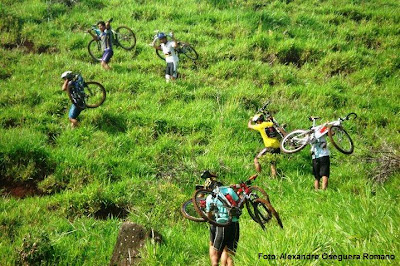Update: Aug 16, 2011
The violence in Veracruz state has now become something to write home about. Fortunately not in the Veracruz City - Acayucan corridor, including Catemaco.
Go ahead and cry in Spanish:
http://chingadanews.wordpress.com/2011/08/15/ejecutaremos-a-quien-se-interfiera-zetas-responsabilizan-a-javier_duarte-de-la-matanza-veracruz-verfollow/
now in English:
http://www.borderlandbeat.com/2011/08/veracruz-city-and-state-held-hostage.html
Update: July 11, 2011
Los Tuxtlas were / are happily in the Los Zetas containment area. I think, in the past, they treated the area as a retreat and laid low. Nevertheless there have been dozens of wannabee's representing themselves as Zetas trying to extort local business people.
There have been local shootings, but because of the intransigence of both the local press and institutions, nobody knows whether anything was narco related.
Near Catemaco (about 40 miles away and often mentioned as being in Los Tuxtlas), is a killing field around Rodriguez Clara through which probably no tourist has passed in the last 12 month. Crime and killings, mostly political in that area, are SOP going on for 30 years and totally unrelated to the popular narco gangs.
Los Zetas, who supposedly control southern Veracruz, are now threatened by both the Gulf Cartel to the north and associates of the Sinaloa cartel to the south. Outbursts of violence have occurred in Veracruz City, Coatzacoalcos and Xalapa.
At present the incidence of violence in southern Veracruz is significantly higher than it was a year ago, but not anywhere near the figures in the border state
s, and, personally, nothing to write home about.
First publication: Nov 2010
An abridged history of the narcos in the Tamaulipas to Catemaco corridor.
Mexico has long been used as a staging and transshipment point for narcotics, undocumented immigrants and contraband destined for U.S. markets. During the 1980s and early 1990s, Colombia was the main exporter of cocaine. When enforcement efforts intensified in South Florida and the Caribbean, the Colombians formed partnerships with the Mexico-based traffickers to transport cocaine through Mexico into the United States.
Miguel Ángel Félix Gallardo known as "El Padrino" (The Godfather) in the 1980s became the first drug czar in Mexico to control all illegal drug traffic in Mexico and the corridors along the Mexico-U.S.A. border.
In 1988, Félix Gallardo began to plan for retirement and convened the nation's top narcos to assign them their respective markets in Mexico. The control of the Tamaulipas (US border in Texas) corridor - then becoming the Gulf Cartel - would be left undisturbed.
Juan Nepomuceno Guerra, a bootlegger and smuggler from the 1930's is credited with founding the Gulf Cartel in the Texas border areas in the 1970's. During the 1980's and 1990's, his nephew Juan Garcia Abrego expanded the business to include Colombian cocaine.
Félix Gallardo was arrested in Mexico in April 8, 1989. and is still in a Mexican high security prison where he enjoys reading his
website.
Juan Garcia Abrego was arrested in 1996 and extradited to the US.
Juan Nepomuceno Guerra died in 2001 and never spent a day in jail.
Upon Juan Garcia Abrego´s arrest, Salvador Gómez, assumed control of the cartel. In 1998 he was presumably assassinated by Osiel Cárdenas Guillén, earning Cárdenas the nickname "El Mata Amigos" (The Friend-Killer), who then assumed control.
Cardenas was arrested on 2003 and extradited to the US. Leadership of the cartel then passed to Heriberto Lazcano and cronies.
Los Zetas
Osiel Cárdenas in 1997 had hired Lieutenant Arturo Guzmán Decena, an ex-special forces officer of the Mexican army alleged but not verified to have been trained by the CIA in Georgia. He was soon joined by 30+ other soldiers. They became the enforcement arm of the Gulf Cartel, responsible for most of its violence
Guzmán Decena known as Z1 (Zeta 1, a radio code used by the federal police) was killed in 2002 and succeeded by Z2, Rogelio González Pizaña.
With the arrest of Osiel Cárdenas, Los Zetas in 2003 began its separation from the Gulf Cartel to increase their personal income and initiated a gang war with their former employers, while expanding the geographic reach of their enterprise to include Veracruz and to include extorsion, robbery and kidnappings, along with drug smuggling.
The then leader of the Zetas, Rogelio González was captured in 2004 and Z3, Heriberto Lazcano Lazcano, then took control of the Zetas.
In 2008
the Zetas formed a collaboration with the Beltrán Leyva gang and the Juarez and Sinaloa Cartel.
Early 2010, more serious confrontations between the Gulf Cartel , now again supported by the Sinaloa Cartel, and Los Zetas exploded and are the basis of most of the horror stories coming from the Tamaulipas - Veracruz corridor.
Supposedly the 30+ original Zetas have been joined by several hundred other former military or police agents. Most of the original Zetas are still alive and roaming freely.
Affect on Veracruz.
Veracruz has remarkably not been affected by major narco violence. (Although occasional headlines blast shootouts and killings, they are no more than the norm in Veracruz violence, which, compared to the rest of Mexico is unimpressive.
What has been less reported is the fear factor created in Veracruz by the the extortion of businessmen in entire cities, their kidnappings, and the increase of general organized crime without excessive killings all attributed to "Zetas".
At present Z40, Miguel Treviño Morales is supposedly the commander in Veracruz. He attained that position supposedly after a major shootout at a race track in Veracruz in 2007, which included a major property owner from Catemaco.
The Los Tuxtlas area has seen no violence directly attributed to the narco wars, but is affected by the general sense of insecurity in Mexico, which, locally, is attributed to actions of Los Zetas, but more than likely is of the home grown variety.
Links
http://en.wikipedia.org/wiki/Drug_war_in_Mexico
http://en.wikipedia.org/wiki/Los_zetas

























